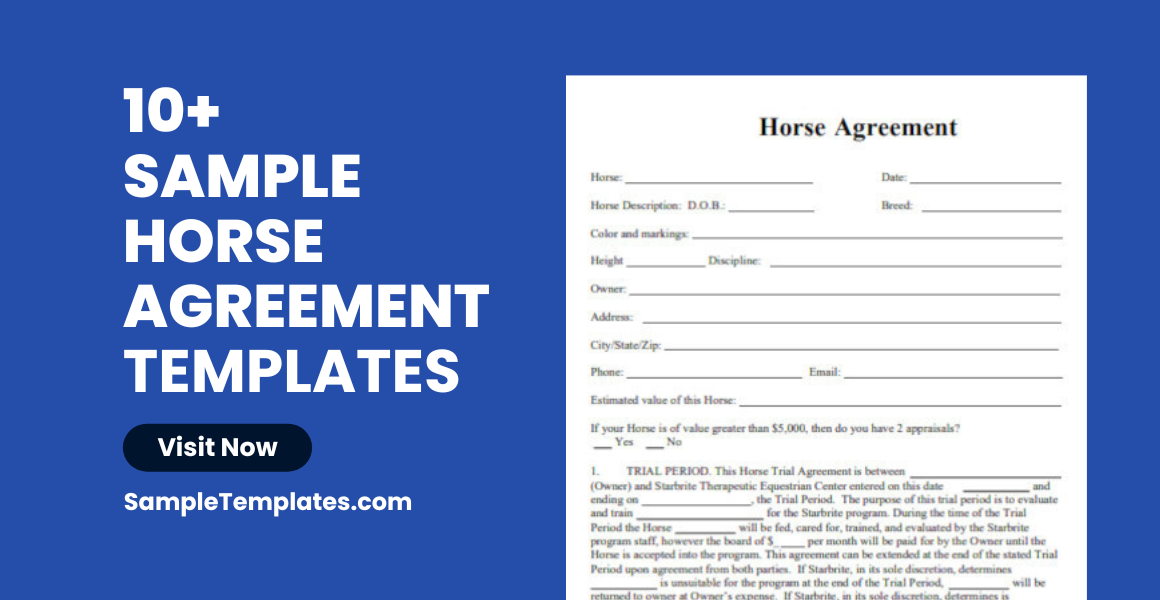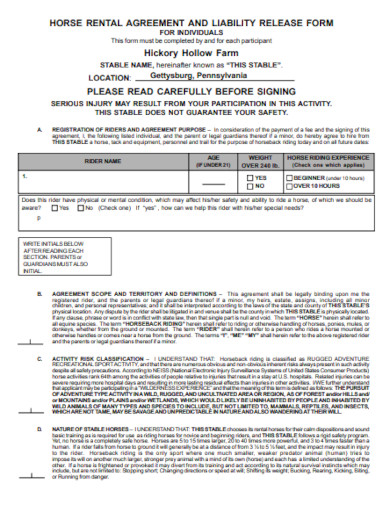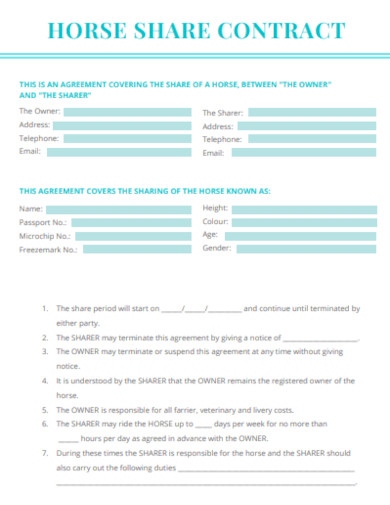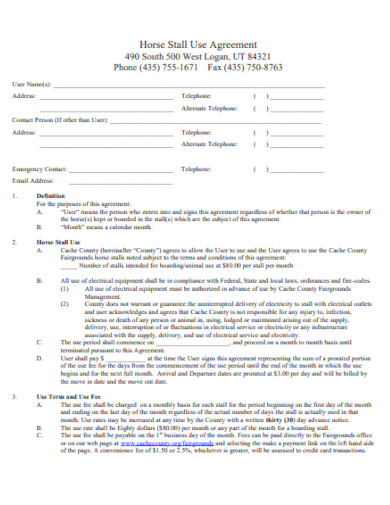Embark on a seamless equine exchange with our expertly crafted Horse Agreement samples. Tailored for clarity and legal precision, these documents are essential for buyers, sellers, and lessees in the United States. Ensure the protection of your interests and the welfare of your horses with sample agreements that cover all pertinent details, from ownership terms to care provisions. Our Samples are designed to foster trust and transparency in every transaction, paving the way for a smooth and secure equine partnership.
10+ Horse Agreement Samples
1. Sample Horse Purchase Agreement Template
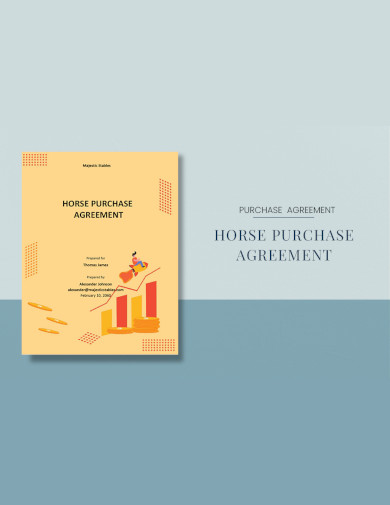
2. Sample Horse Training Agreement Template
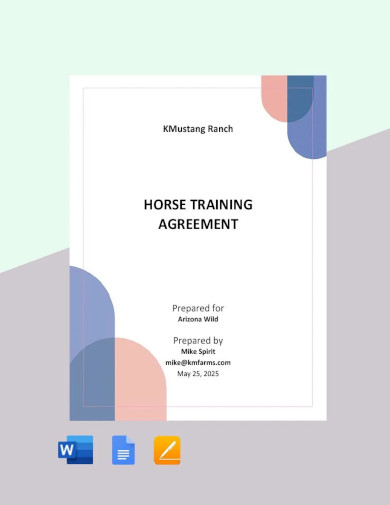
3. Sample Horse Sale Agreement Template
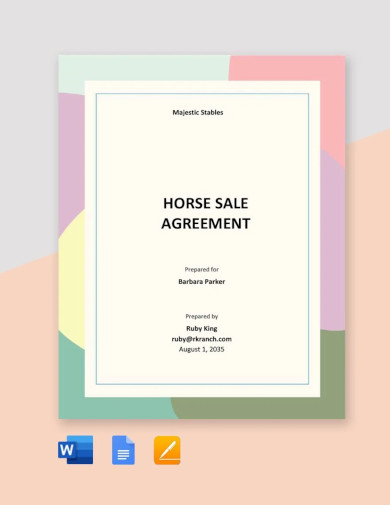
4. Sample Horse Boarding Agreement Template
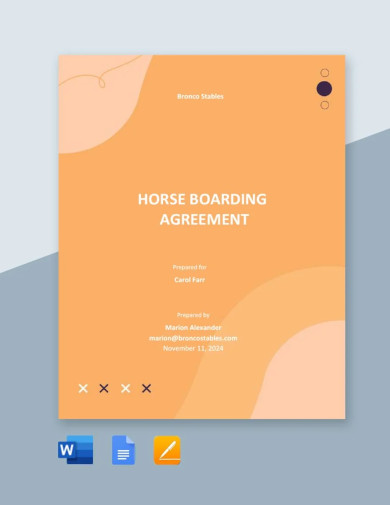
5. Sample Lease Horse Agreement Template
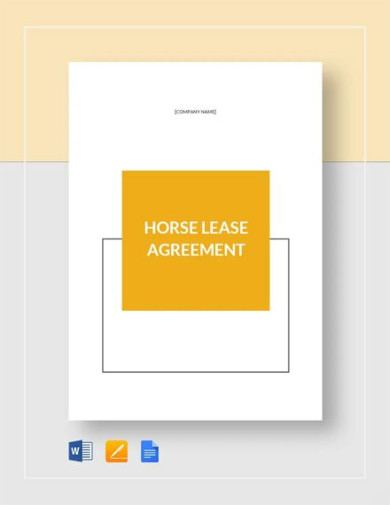
What is a Horse Agreement?
When it comes to equine transactions, a horse agreement is an essential document that outlines the terms and conditions of the sale, lease, or loan of a horse. This legally binding contract ensures that all parties involved have a clear understanding of their rights and responsibilities, helping to prevent disputes and misunderstandings. Whether you’re a seasoned equestrian or a first-time horse owner, understanding the intricacies of a horse agreement is crucial for a smooth and transparent equine exchange.
Understanding the Different Types of Horse Agreements
Purchase Agreements
A purchase agreement is used when buying or selling a horse. It details the sale’s specifics, including the horse’s identity, price, and any warranties or representations made by the seller. This agreement serves to prevent misunderstandings and provides a legal recourse should any disputes arise post-sale.
Lease Agreements
Leasing a horse is common for individuals who are not ready to own one outright. A lease agreement outlines the terms of the lease, such as duration, lease fee, and the responsibilities of each party regarding the horse’s care and use. It’s a flexible option that allows for equine enjoyment without the full commitment of ownership.
Boarding Agreements
For horse owners who do not have their own stables, boarding agreements are crucial. These sample contracts between the horse owner and the stable owner specify the boarding fees, services provided, and the care expected for the horse. They ensure that the horse is well-cared for and that the expectations of both parties are met.
The Importance of a Well-Crafted Horse Agreement
A well-drafted horse agreement is vital in safeguarding the welfare of the horse and the interests of the involved parties. It should be comprehensive and clear, covering all potential issues that could arise. This includes detailing the horse’s health and condition, any trial periods, return policies, and insurance requirements.
Key Elements of a Horse Agreement
To be effective, a horse agreement must include certain key elements:
- Identification of Parties: The full names and contact information of all parties involved.
- Description of the Horse: A detailed description of the horse, including age, breed, color, sex, and any registration details.
- Terms of the Agreement: The specific terms, including the length of the agreement, financial arrangements, and any other conditions.
- Responsibilities and Obligations: Clearly defined responsibilities for each party, such as who is liable for veterinary care, feeding, and training.
- Signatures: The legally binding signatures of all parties involved.
Examples of Horse Agreements in Action
Consider Jane, an equestrian who wishes to lease a horse from a local stable. She enters into a lease agreement that stipulates she can use the horse for riding and competitions, while the stable owner remains responsible for the horse’s primary care. The agreement outlines the lease’s duration, the monthly fee, and states that Jane must carry personal liability insurance.
In another scenario, John decides to purchase a horse from a breeder. They draft a purchase agreement that includes the horse’s purchase price, the payment schedule, and a clause that allows John to return the horse within 30 days should a vet find any undisclosed health issues.
The Role of Disclosures in Horse Agreements
Full disclosure is a critical aspect of horse agreements. Sellers are expected to disclose any known health issues, behavioral problems, or vices that the horse may have. This section of the agreement protects the buyer from undisclosed issues that could affect the horse’s suitability for their intended use.
The Necessity of a Horse Agreement
Entering into any equine-related transaction without a horse agreement is akin to sailing uncharted waters without a map. A horse agreement is not just a formality; it’s a critical document that serves multiple purposes, ensuring the protection and clarity for all parties involved in the horse’s life and activities.
Risk Management A horse agreement mitigates risks by clearly outlining the responsibilities and expectations of each party. It acts as a safeguard against misunderstandings that could lead to disputes or legal issues.
Legal Protection In the event of disagreements or legal challenges, a horse agreement provides a written record of the terms agreed upon by all parties. This can be invaluable in court or during negotiations.
Clarity of Terms A horse agreement spells out the specifics of the transaction, including the horse’s details, the financial arrangements, and the terms of care and custody. This clarity prevents assumptions and ensures that everyone is on the same page. You can also see more templates like Horse Lease Agreements.
Welfare of the Horse The agreement can stipulate the standard of care required for the horse, ensuring its well-being. It can also sample outline procedures for emergency situations, further protecting the horse.
Financial Clarity By detailing costs, payment schedules, and who is responsible for additional expenses, a horse agreement prevents financial disputes and ensures that the horse receives the necessary care without delay.
Transfer of Rights and Responsibilities Whether it’s a lease, purchase, or boarding situation, a horse agreement transfers certain rights and responsibilities from the owner to another party. This design document makes those transfers clear and legally binding.
Insurance and Liability A horse agreement can require the lessee or borrower to carry insurance, reducing the owner’s liability and ensuring that any damage or injury can be financially covered.
Preservation of Relationships By preventing disputes and misunderstandings, a horse agreement helps maintain positive relationships within the equine community, which is beneficial for networking and future transactions.
Finalizing the Agreement
Once all terms are agreed upon, the horse agreement should be signed and dated by all parties involved. It’s recommended to have witnesses or a notary public to sign the agreement to add an extra layer of authenticity and protection. Each party should receive a copy of the signed agreement for their records.
When to Use a Horse Agreement?
A horse agreement is not just a precaution; it’s a necessity at several junctures in the life of a horse and its interactions with people. Here are key instances when a horse agreement should be employed:
Buying or Selling a Horse
When ownership of a horse is being transferred, a purchase agreement is essential. It ensures that both buyer and seller agree on the terms of the sale, including price, payment plan, and any guarantees or disclosures about the horse’s health and history.
Leasing a Horse
Whether you’re leasing out your horse or looking to lease one, a lease agreement is crucial. It defines the lease terms, including duration, cost, and the lessee’s rights regarding the horse’s use, ensuring that the arrangement is clear and mutually beneficial.
Boarding Services
If you’re providing a home for someone else’s horse or boarding your own horse at a facility, a boarding agreement is necessary. This contract outlines the services provided, the cost, and the care standards expected, protecting the interests of both the horse owner and the facility provider.
Breeding Arrangements
When a horse is being bred, a breeding contract between the owner of the mare and the owner of the stallion should be in place. This agreement should cover the stud fee, care of the mare, and any specific terms related to the foal.
Training Services
If a horse is being sent for training, a training agreement should be signed. This outlines the expectations, the duration of the training, the responsibilities of the trainer, and the payment terms.
Loan Agreements
Sometimes, a horse is loaned to another person for a specific period. A loan agreement would specify the terms of this arrangement, similar to a lease, but often without the exchange of money.
Sharing Arrangements
In situations where a horse is shared between multiple parties, a sharing agreement can outline each person’s rights, responsibilities, and financial contributions to avoid conflicts.
Trial Periods
Before finalizing a purchase or lease, a trial period might be agreed upon. A trial agreement should be used here to define the terms of the trial, the care of the horse during this period, and the conditions under which the trial can be converted into a purchase or lease.
6. Sample Horse Purchase and Sale Agreement
7. Sample Horse Rental Agreement Template
8. Sample Horse Share Contract Agreement Template
9. Sample Horse Trial Agreement Template
10. Sample Horse Agistment Agreement Template
11. Sample Horse Stall Use Agreement Template
Legal Significance of a Horse Agreement
The legal importance of a horse agreement cannot be overstated. It is a legal binding contract that holds significant weight in the eyes of the law and serves several critical legal functions:
Enforceability A horse agreement, when properly drafted and signed, is enforceable in a court of law. This means that if one party fails to uphold their end of the contract, the other party can seek legal recourse.
Evidence of Terms In the event of a dispute, a written horse agreement provides clear evidence of the terms that were agreed upon by all parties. This can be crucial in resolving misunderstandings or proving the intentions of each party at the time of the agreement.
Risk Allocation The agreement delineates the risks each party is assuming. For instance, it may specify who is liable if the horse becomes injured or causes injury to others, thereby allocating risk appropriately and helping to prevent future legal issues.
Compliance with Statutes Many jurisdictions have specific statutes that govern the sale and lease of horses, and a horse agreement helps ensure that these transactions comply with relevant laws. For example, some states in the U.S. require certain disclosures or terms to be in writing for the sale of livestock.
Clarification of Ownership A horse agreement can establish clear ownership, which is important for liability, registration, and insurance purposes. It can also prevent disputes related to ownership and possession that could otherwise result in legal action.
Outline of Responsibilities By clearly outlining the responsibilities of each party, including care, custody, and financial obligations, the agreement minimizes the potential for legal disputes over who is responsible for what aspects of the horse’s welfare and maintenance.
Modification of Common Law Common law principles will apply in the absence of a written agreement. A horse agreement allows parties to modify these principles to suit their specific needs and circumstances, providing a customized legal framework for their transaction.
How to Create a Horse Agreement?
Creating a comprehensive Horse Agreement is crucial for any equine transaction. Follow these steps to ensure a legally sound and mutually beneficial contract:
1. Identify the Parties: Clearly state the names and addresses of the seller, buyer, and if applicable, the lessee.
2. Describe the Horse: Include a detailed description of the horse, such as breed, age, color, markings, registration details, and microchip number.
3. Outline the Agreement Terms: Specify the sale price, payment plan, and any deposit required. Clarify if the agreement is a sale, lease, or breeding loan.
4. Health and Veterinary Information: Attach the horse’s medical records, vaccination history, and a recent veterinary inspection certificate.
5. Warranties and Representations: The seller should disclose any known health issues or behavioral quirks. Both parties may agree on a trial period.
6. Pre-Purchase Exam: Agree on the terms for a pre-purchase veterinary exam, if desired, to confirm the horse’s health status.
7. Ownership Transfer: Detail the process for transferring ownership, including registration sample papers and any other necessary documentation.
8. Liability and Risk: Define who holds liability for the horse at each stage of the transaction and after the sale is complete.
9. Contingencies: Include any conditions that must be met before the agreement is finalized, such as passing a drug test or obtaining insurance.
10. Signatures: Both parties should sign and date the agreement. It’s advisable to have witnesses or a notary public for additional legal standing.
What is a Horse Lease Agreement?
A horse lease agreement is a formal contract between two parties: the horse owner and the lessee. This document outlines the terms under which the lessee is permitted to use the horse and the responsibilities each party agrees to uphold during the lease term. It’s a popular option for individuals who wish to enjoy the benefits of horse ownership without the long-term commitment or upfront cost of purchasing a horse.
In conclusion, a horse agreement is a cornerstone of any equine transaction, ensuring all parties are aware of their roles and responsibilities. It provides a safety net for both the human and equine participants, fostering trust and professionalism in the equine community. Whether you’re leasing, purchasing, or boarding, a comprehensive horse agreement is the first step towards a successful and enjoyable equine relationship.
Related Posts
FREE 10+ Mentoring Agreement Samples In MS Word | Apple Pages | PDF
FREE 10+ Partner Agreement Samples In MS Word | Google Docs | Apple Pages | PDF
FREE 10+ Individual Agreement Samples In MS Word | Google Docs | Apple Pages | PDF
FREE 10+ Strategic Agreement Samples In MS Word | Google Docs | Apple Pages | PDF
FREE 10+ Equity Agreement Samples In MS Word | Google Docs | Apple Pages | PDF
FREE 10+ Producer Agreement Samples in MS Word | Apple Pages | PDF
FREE 10+ Grant Agreement Samples In MS Word | Apple Pages | PDF
FREE 8+ Meeting Agreement Samples in MS Word | Google Docs | Apple Pages | PDF
FREE 10+ Community Agreement Samples In MS Word | Google Docs | PDF
FREE 8+ Real Estate Option Agreement Samples in MS Word | PDF
FREE 10+ Call Option Agreement Samples In MS Word | PDF
FREE 10+ Advertising Agreement Samples In MS Word | Google Docs | Apple Pages | PDF
FREE 10+ Car Agreement Samples In MS Word | Google Docs | Apple Pages | PDF
FREE 10+ Option Agreement Samples In MS Word | Google Docs | Apple Pages | PDF
FREE 9+ Project Management Agreement Samples in DOC | PDF
